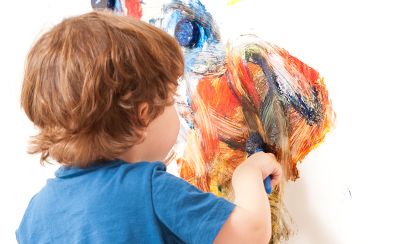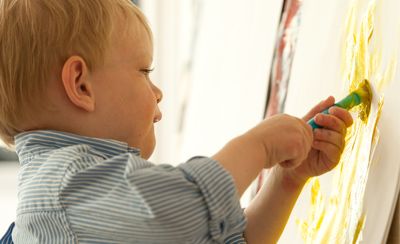Interdisciplinary Model Program in the Arts for Children and Teachers
Inviting Creativity: The Teacher's Role in Fine art

At that place are many different ways to approach the didactics of art. This commodity identifies and critiques instructor-directed, teacher-guided, and child-centered approaches. What is the teacher's role in children'southward art?
An adult does not need to exist a talented artist to provide meaningful fine art experiences for children, only can stimulate, guide, and model creativity and exploration. Most of the states recognize the importance of early childhood fine art, but not everyone would hold nigh what it entails. Is scribbling art? Can coloring in a coloring book be considered art? This article provides guidelines for determining the artistic merits of an activeness or approach to art.
Approaches to Teaching Art
Teacher-directed:
Some art projects are structured and teacher-directed. The teacher has an idea of what to brand and how to go about information technology. Specific directions are given to ensure a recognizable product. Often, there is trivial input from the children. For instance, a teacher distributes a piece of paper with an outline of a tree. The children are instructed to employ a nighttime color, such as black or dark-brown, to color in the trunk and green for the peak. They also cutting or tear small circles from red construction paper. These are pasted onto the green summit. The completed apple trees look about identical. Mostly, this arroyo is used when art is approached with the unabridged group or minor groups of children. Most craft projects are teacher-directed. Seefeldt (1995) critiques teacher-directed fine art. Asking children to consummate patterned artwork or to copy adult models of fine art undermines children'southward sense of psychological rubber and demonstrates disrespect for children including their ideas, abilities, and creativity. Children who are frequently given patterns to cut out or outlines to color in are in fact existence told that they, and their fine art, are inadequate. Seefeldt gives the example of giving children egg cartons to paint and paste eyes to make caterpillars, an activity that she sees as ridiculous when compared to the artwork of children of Reggio.
Child-centered:
An opposite approach is to exist unstructured and completely child-centered. A teacher may distribute pieces of paper and encourage children to make whatever they want or encourage them to visit the easel or art heart. In this approach, children have much input and choice. There is very picayune structure. Some children do very well with this approach. They may have a bank of ideas to correspond through art. They may also encounter endless artistic possibilities at the easel or fine art center. Many children, however, are uncomfortable with this approach. It may be besides loosely structured. Some children speedily tire of inventing their ain daily art program. They look to the teacher for some construction, guidance, or possibilities.
According to Wright (2003), unsupported arts learning in the classroom sometimes tin pb to a laissez-faire or "annihilation goes" type of practice. In this non-interventionist arroyo, the underlying conventionalities is that whatever children do in the arts in valuable. For a instructor to interfere would stifle a child's creativity. This hands-off approach restricts the teacher's function to one of organizing the environment only and discourages ane from suggesting ideas or processes that could mediate and scaffold children's learning. With no input from others, children tin can sometimes become bored and even frustrated with experiences that invite only independent experimentation. Children cannot create from nothing. They need groundwork ideas and suggestions. Teacher-directed and kid-centered approaches are extremes. Teachers can elect for a compromise using support and guidance by adopting the part of facilitator within a guided approach.
Teacher as Facilitator:
A teacher-guided approach offers the best of the ii erstwhile approaches: subtle construction with much child direction and input. For example:
- A teacher supplies the theme.
"Children, it'south getting very close to summer. Today, nosotros volition make a picture that reminds us of this season." Although the theme is given, at that place is no specified production. Children are free to use paint, crayons, markers, or clay to brand their own versions of what summer means to them. - A instructor introduces new materials at the fine art center.
"Today I put some spools and buttons near the easels and art tabular array. I want you to look at them and think of how they might be used in art. Try out different ways of using them." Children are gratis to use them as brushes, make a stamped impression, or paste them to a collage, every bit long as the rules for the art center are upheld. - A instructor extends or builds upon an existing activity or suggests a new technique.
"I've noticed how much nosotros enjoy easel painting with our long-handled brushes. I found these small tree branches exterior and am leaving them at the easels. Let's see if we could use them to paint with." Or, "Let me prove you some other mode of doing watercolor by outset wetting your newspaper." Or, "I see how much you enjoy your paper-purse boob. If yous like, I could bear witness yous how to sew 1 out of textile." Or, "Did you enjoy your paper weaving? Would you similar to learn how to weave on a loom with yarn?" - A instructor poses a problem.
"Let'southward see how many different shapes nosotros can cut out of newspaper for pasting." Or, "How could we use these empty boxes and ribbon?" Or, "What volition happen if we try painting on newspaper or the colored pages in this magazine?" - A teacher extends art into other curricular areas.
"There seems to be a lot of excitement in your flick. Would you similar to share it by telling me a story?" Or, "The dog you lot painted looks and so happy, let's work together and write a verse form most information technology." Or, "Maybe y'all would similar to plan a play for your ferocious dinosaur."
Different approaches may work for sure activities and certain children. Young children volition not automatically discover how to use a watercolor set. They will need some direction and instruction in its use and care. They need not, nonetheless, exist told what to brand or what it should await similar. For example, Emily is having difficulty deciding what to include in her summer picture. Her teacher senses her frustration and asks her to name things that remind her of summertime. Emily answers, "Sun and swimming." Her teacher further structures the task by asking Emily to choose one. With the teacher'south subtle guidance, Emily chooses the sun and at present must decide if she should utilize paints, watercolor, crayons, markers, or clay to represent it.

Young children will need some management and didactics when presented with new art tools and materials.
Child-Centered Art or Teacher-Directed Projects?
Arts and crafts are terms that are often viewed as opposite. Hirsch (2004) provides a distinction. The motivation for art comes from within the child. Immature children are dealing with autonomy and initiative. They are often not responsive or interested in teacher-directed experiences. This is especially true with fine art. When art is forced or extrinsically motivated, it may lack meaning, expressiveness, or detail. The art may reflect external expectations, or the autonomous child may purposefully create annihilation but what was asked for. The arroyo is reproductive in that the child merely reproduces the teacher's production.
By contrast, when the motivation and purpose for art comes from within the child, the artwork reflects personal meaning and purpose. When children have costless access to materials in an art eye, they have the opportunity to create meaning and purpose. The approach is productive, not reproductive. In terms of arroyo, fine art activities are viewed every bit developmentally appropriate while crafts are frequently instructor-directed, product-oriented, and lacking artistic merit. The term project is presently used in place of craft. Although some would refer to instructor-directed activities as crafts, the terms are not interchangeable. Crafts have artistic merit, and craftspeople work long and hard to produce products, many of which reverberate their culture. Crafts may likewise be functional every bit with candles, jewelry, clothing, or wind chimes. Therefore, it would not be fair to use crafts in the aforementioned sense of teacher-directed art projects. Instead, teacher-directed projects, rather than crafts are the opposite of child-centered art. Substituting teacher projects for art does children a disservice for information technology robs them of the opportunity to make self-expressive, cocky-initiated art.

In a child-centered art activity the finished product may not exist recognizable!
Kid-Centered Art Activities or Teacher-Directed Projects
Art Activities | Instructor-Directed Projects |
| are creative, unique, original | appear mass-produced and very similar |
| are open-concluded and unstructured | are closed-ended and structured |
| are child-centered and kid-directed | are teacher-centered and instructor-directed |
| come from within the kid | are imposed from without by the teacher |
| involve self-expression | involve copying and imitating |
| foster autonomy | foster compliance and following directions |
| are procedure-oriented | are production-oriented |
| may non appeal to adults because the finished product may not be recognizable | usually entreatment to adults because the finished production is recognizable |
| may non be useful or practical | may be useful and practical |
| are success-oriented, no fear of failure | may be unsuccessful if the child is unable to approximate the teacher's model or standard |
| empower children to decide on content | are decided past the teacher and related to holiday, flavour, theme, unit of study |
| please the kid | please adults |
| demand open blocks of time | may involve time constraints |
Is There a Place for Instructor Projects?
Although teacher projects should non dominate your art program, they do have a place and are to your art plan as spices are to cooking. Some people avoid spices while others apply them sparingly to enhance but not overpower or dominate the gustatory modality of food. When should teacher projects exist used? They tin can be used occasionally
- with older children who have a solid foundation in processing and are interested in learning how to brand art products.
- when children tire of visiting the fine art center and announced to run out of ideas for processing. They announced stuck or out of ideas. It appears the fine art heart is not beingness used.
- to innovate children to new cultures by straight experiencing representative crafts. The procedure involved in making crafts must be tailored to run into the developmental needs of your group.
- while assuasive for private expression, as in the choice of color or type of decoration added. For instance, children can be taught how to make a piñata without specifying what it should wait similar when finished.
From Art and Creative Evolution for Young Children5th edition by Robert Shirrmacher. © 2006. Reprinted with permission of Delmar Learning, a division of Thomson Learning.

Source: https://www.communityplaythings.com/resources/articles/2006/child-centered-art-vs-teacher-directed-projects
Post a Comment for "Interdisciplinary Model Program in the Arts for Children and Teachers"